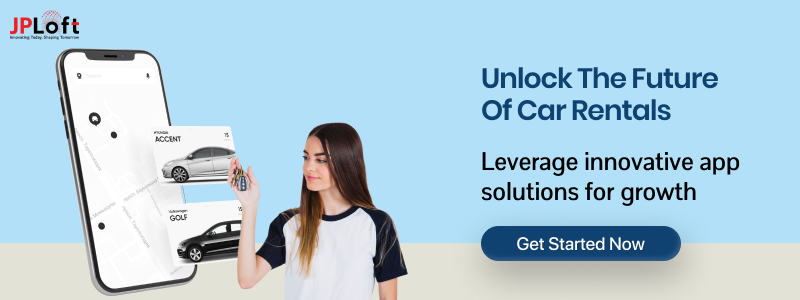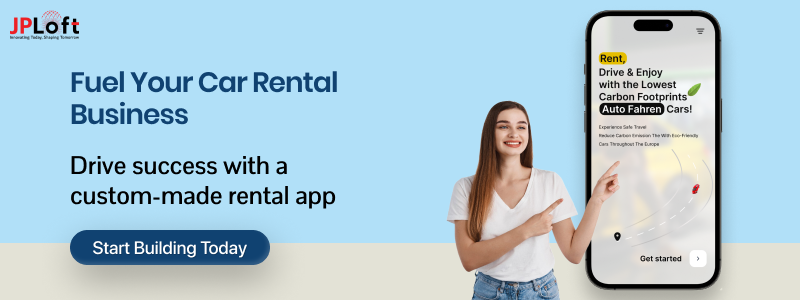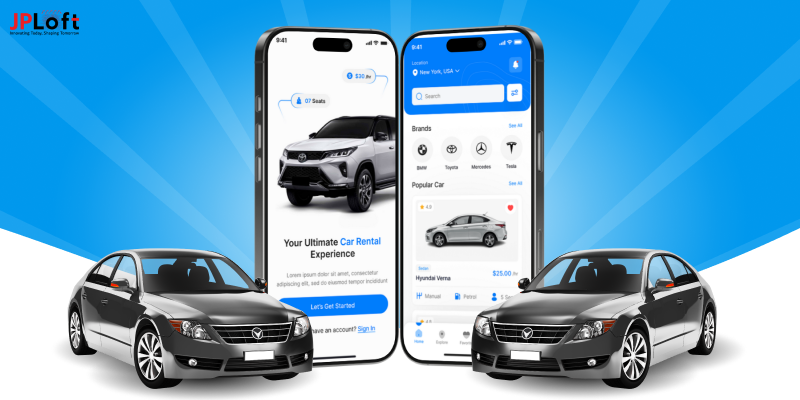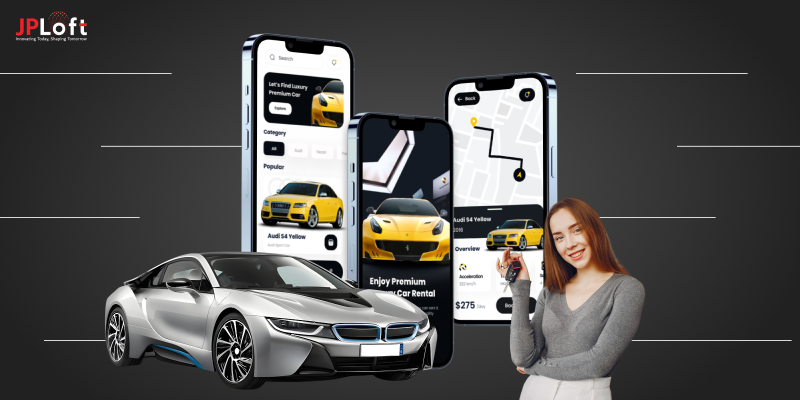Thinking of Creating a Car Rental App? Here’s Why Now is the Perfect Time
With the global car rental market projected to surpass $125 billion by 2030, this sector presents immense opportunities for businesses. Features like touchless entry and real-time vehicle tracking are no longer optional; they’re setting the standard for innovation and user satisfaction.
Understanding the cost to create a car rental app is essential for businesses looking to thrive in this competitive landscape. Every feature—whether basic or advanced—impacts the budget and determines the app's ability to stand out.
This complete guide to car rental app development cost provides a step-by-step breakdown to help entrepreneurs and businesses plan strategically, optimize resources, and maximize their ROI.
Let’s dive in by exploring the fundamentals of car rental apps.
What Is a Car Rental App?
A car rental app is a mobile platform that enables users to find, book, and rent vehicles on demand. It streamlines the traditional rental process, offering a more flexible and user-friendly experience.
Key Functionalities Typically include:
-
-
User-friendly interface for easy car search
-
Booking system to reserve vehicles in advance
-
Payment integration for seamless transactions
-
GPS tracking for real-time vehicle location
-
Popular apps like Turo, Zipcar, and Hertz have set high standards in the industry. Turo, for instance, connects car owners with renters, offering a broad variety of vehicles. Zipcar focuses on short-term rentals with a fleet available for immediate use.
Car Rental Industry Market Overview
This section covers key statistics, emerging trends, and regional insights shaping the future of the car rental market within the on-demand industry, highlighting significant growth, technological advancements, and evolving consumer preferences.
► Market Growth
The global car rental market was valued at $116.34 billion in 2022 and is projected to reach $182.16 billion by 2026, growing at a CAGR of 11.2%.
This growth reflects the increasing demand for on-demand, flexible transportation options across the globe. [Grand View Research]
-
-
Global Demand: The shift towards on-demand services is driving the rapid growth of the market.
-
Future Projections: By 2030, the market is expected to reach $278.03 billion.
-
► Regional Market Insights
North America holds a 45% share of the global car rental market in 2023.
The region remains a dominant player due to its established infrastructure and high demand for car rental services.[Mordor Intelligence]
-
-
Market Dominance: Strong infrastructure and high consumer demand contribute to North America's leading position.
-
Expansion Potential: Despite dominance, regions like Asia Pacific are showing faster growth.
-
Asia Pacific is expected to experience the highest growth rate in the coming years.
Urbanization and economic development in this region are contributing to the rising demand for flexible mobility solutions.
-
-
Urbanization Factor: Increased urbanization and rising disposable income are key drivers of growth.
-
Midle-Class Growth: A growing middle class demands more flexible transportation options.
-
► Competitive Landscape in the Car Rental Industry
Major players in the global car rental market include Avis Budget Group Inc., Sixt, Hertz Corp., Enterprise Holdings Inc., and Europcar Group.
These companies dominate the market, providing a wide range of rental services and fleets.
-
- Enterprise Holdings: As of 2020, Enterprise Holdings holds a 40% market share in the U.S. car rental industry, making it the largest player in the market.[Wikipedia]
- Avis Budget Group: Avis Budget Group, which includes brands like Avis and Budget, is a significant competitor in the U.S. market, though specific market share figures are not readily available.[Mordor Intelligence]
- Hertz Global Holdings: Hertz, operating brands such as Hertz, Dollar, and Thrifty, also holds a substantial share of the U.S. car rental market, though exact percentages are not specified.[Mordor Intelligence]
- Independents: Independent car rental agencies in the U.S. collectively operate about 42,000 cars, averaging ten cars per location, and generate an estimated $24.7 billion in revenue. [Zippia]
These figures highlight the booming market of car rental apps, which makes it the best time to develop a car rental app and enter this highly profitable market.
► Key Market Trends
The Mobility-as-a-Service (MaaS) model is reshaping the car rental market.
This trend integrates car rentals, ridesharing, and public transportation into a unified service, providing consumers with more seamless and flexible options.
-
-
On-Demand Services: The MaaS trend caters to consumers looking for integrated, on-demand mobility solutions.
-
Seamless Mobility: Platforms offering MaaS allow easier navigation and booking across various transport modes.
-
The electric vehicle (EV) market is projected to grow at a CAGR of 33.6%, reaching $1,070.77 billion by 2030.[Grand View Research]
Car rental companies are increasingly adopting EVs to meet the rising demand for sustainable transportation.
-
-
Sustainability Focus: Eco-conscious consumers are driving the demand for EV rentals.
-
Fleet Diversification: Rental companies are diversifying their fleets by adding more electric vehicles.
-
► Technology-Driven Efficiency
Artificial Intelligence (AI) is optimizing fleet management in the car rental industry.
AI tools help predict maintenance needs, adjust pricing, and improve operational efficiency, offering a more seamless experience for customers. [AI News]
-
-
Predictive Maintenance: AI helps predict and prevent maintenance issues, improving fleet longevity and customer satisfaction.
-
Dynamic Pricing: AI-driven pricing systems help optimize rental rates based on demand fluctuations.
-
Now that you've explored the market and opportunities in car rental apps, let's dive into the unique features mentioned below in this car rental app development cost guide and see how they can influence the overall cost.
Key Features of a Car Rental App and Associated Costs
Creating a successful car rental app requires carefully selected features to cater to both users and administrators. And these significantly affect the overall cost of developing a car rental app.
Below, we’ll explore the essential features, along with their estimated development costs.
1] Essential Features for Customers
These features ensure users have a seamless and convenient experience, from registration to booking.
-
-
User Registration and Profile Management: Allows users to sign up, log in, and manage their personal details. Social media integration enhances convenience.
-
Search and Booking System: Enables users to filter cars by type, price, location, or availability and proceed with bookings.
-
Payment Integration: Provides secure and seamless payment methods, including credit/debit cards, mobile wallets, and in-app payment.
-
GPS Tracking and Navigation: Helps users locate nearby cars and navigate to pick up points or destinations.
-
Push Notifications and Alerts: Keeps users informed about booking confirmations, reminders, and special offers.
-
2] Admin Panel Features
-
-
Fleet Management: Allows admins to monitor vehicle availability, status, and maintenance schedules.
-
Customer Support Tools: Facilitates quick resolution of user queries or complaints via integrated chat or ticketing systems.
-
Reporting and Analytics Dashboard: Offers insights into bookings, revenue, and user behavior to help make data-driven decisions.
-
3] Advanced Features (Optional but Recommended)
Advanced features enhance user satisfaction and give your app a competitive edge.
-
-
Real-time Vehicle Availability: Shows live updates of available cars, helping users make quick decisions.
-
In-app Chat or Customer Support: Provides direct communication with support teams or vehicle owners for immediate assistance.
-
Multi-language and Currency Support: Expands the app’s reach globally by catering to diverse audiences.
-
Dynamic Pricing Algorithms: Adjusts prices based on demand, location, or season to maximize revenue.
-
4] Estimated Costs for Features
If you are wondering how much does it cost to build a car rental app? The price can vary based on whether you are creating a basic app or a full-fledged platform with advanced functionalities.
|
Feature |
Development Time (Hours) |
Estimated Cost ($) |
|
User Registration & Profile |
$80 - $120 |
$4,000 - $6,000 |
|
Search & Booking System |
$150 - $200 |
$7,500 - $10,000 |
|
Payment Integration |
$120 - $150 |
$6,000 - $7,500 |
|
GPS Tracking & Navigation |
$100 - $140 |
$5,000 - $7,000 |
|
Push Notifications & Alerts |
$60 - $80 |
$3,000 - $4,000 |
|
Fleet Management |
$120 - $160 |
$6,000 - $8,000 |
|
Customer Support Tools |
$100 - $140 |
$5,000 - $7,000 |
|
Reporting & Analytics Dashboard |
$150 - $200 |
$7,500 - $10,000 |
|
Real-time Vehicle Availability |
$80 - $100 |
$4,000 - $5,000 |
|
In-app Chat or Customer Support |
$100 - $140 |
$5,000 - $7,000 |
|
Multi-language & Currency Support |
$80 - $120 |
$4,000 - $6,000 |
|
Dynamic Pricing Algorithms |
$150 - $200 |
$7,500 - $10,000 |
Note: The cost to create a car rental app can vary depending on the complexity of the feature, the location of the development team, and the chosen platform (iOS, Android, or both).
For example, hiring developers in North America typically costs more than in Eastern Europe or Asia.
Having explored the unique features and their impact on the cost of developing a car rental app, let’s now dive into the development process and its associated costs in this step-by-step guide to car rental app development costs.
Step-by-Step Cost Breakdown of the Development Process
Understanding the step-by-step breakdown of costs involved in car rental app development is essential for effective budgeting. Let’s explore each stage in detail, with insights into tasks, estimated costs, and why they matter.
Step 1: Pre-Development Stage
This stage involves laying the foundation for the app by conducting market research and creating a blueprint.
-
-
Business Analysis and Research: Identifies target users, competitors, and market trends to define app objectives.
-
Prototyping and Wireframing: Creates a visual representation of the app’s structure, ensuring the design aligns with user needs.
-
Estimated Costs
|
Task |
Time (Hours) |
Cost ($) |
|
Market Research |
$60-$100 |
$3,000 - $7,000 |
|
Prototyping |
$50-$80 |
$2,000 - $5,000 |
|
Wireframing |
$40-$70 |
$1,000 - $3,000 |
|
Total |
$150-$250 |
$6,000 - $15,000 |
Step 2: UI/UX Design
A well-crafted design ensures user satisfaction and increases retention. Intuitive layouts and smooth navigation are key.
-
-
Importance of Intuitive Design: A user-friendly interface can boost engagement and conversions.
-
Tasks Involved: Includes creating visual elements, typography, color schemes, and interactive elements.
-
Estimated Costs
|
Task |
Time (Hours) |
Cost ($) |
|
Visual Design |
$80-$120 |
$3,000 - $6,000 |
|
Interaction Design |
$60-$100 |
$2,000 - $5,000 |
|
Prototyping |
$50-$80 |
$2,000 - $4,000 |
|
Total |
$190-$300 |
$5,000 - $15,000 |
Step 3: Frontend and Backend Development
Development forms the backbone of your car rental app, focusing on both appearance and functionality.
-
-
Native vs. Hybrid Development: Native apps deliver superior performance but are costlier. Hybrid apps are budget-friendly but may compromise slightly on user experience.
-
Integration Tasks: Incorporates APIs, databases, and third-party services for features like payment, GPS, and push notifications.
-
Estimated Costs
|
Task |
Time (Hours) |
Cost ($) |
|
Frontend Development |
$300-$400 |
$15,000 - $20,000 |
|
Backend Development |
$400-$500 |
$20,000 - $30,000 |
|
API Integration |
$100-$150 |
$5,000 - $10,000 |
|
Total |
$800-$1,050 |
$30,000 - $80,000 |
Step 4: Quality Assurance (QA) and Testing
Testing ensures your app is bug-free, secure, and ready for launch. Both manual and automated testing are involved.
-
-
Manual Testing: Simulates user actions to identify bugs.
-
Automated Testing: Uses scripts to test features like payment, navigation, and booking processes.
-
Estimated Costs
|
Task |
Time (Hours) |
Cost ($) |
|
Manual Testing |
$60-$100 |
$3,000 - $6,000 |
|
Automated Testing |
$40-$80 |
$2,000 - $4,000 |
|
Security Testing |
$20-$40 |
$1,000 - $2,000 |
|
Total |
$120-$220 |
$5,000 - $15,000 |
Step 5: Launching Your App
Once development is complete, your app needs to be launched on app stores with proper compliance.
-
-
App Store Fees: Includes fees for publishing on platforms like the Apple App Store ($99/year) and Google Play Store ($25 one-time).
-
Deployment Process: Involves setting up servers, ensuring app store compliance, and conducting final tests.
-
Estimated Costs
|
Task |
Cost ($) |
|
App Store Fees |
$100 - $150 |
|
Server Setup |
$1,000 - $3,000 |
|
Deployment |
$900 - $1,850 |
|
Total |
$2,000 - $5,000 |
Step 6: Post-Launch Maintenance
Maintenance ensures your app remains functional and competitive.
-
-
Updates and Bug Fixes: Includes rolling out updates and addressing user-reported issues.
-
Server Maintenance: Ensures smooth app performance, especially during peak usage.
-
Estimated Costs
|
Task |
Monthly Cost ($) |
|
App Updates |
$1,000 - $2,000 |
|
Bug Fixes |
$500 - $1,000 |
|
Server Maintenance |
$500 - $2,000 |
|
Total |
$2,000 - $5,000 |
Each of these stages contributes to the overall cost to build a car rental app, which can range from $50,000 to $120,000 for a medium-complexity app.
Choosing the right mobile app development services will not only help you manage your car rental app’s creation costs effectively but also ensure the final product meets your business goals and user expectations.
Now that we’ve covered the development costs, let’s dive into the factors that impact the overall price in this complete guide to car rental app development costs.
Factors That Impact Development Costs
Several critical factors influence the overall cost to develop a car rental app. Let’s break these down with unique insights, ensuring you understand how each decision affects the budget.
1. Development Team Location and Rates
The geographical location of your development team plays a significant role in determining costs, as hourly rates vary widely.
► Regional Rates
-
- Developers in North America charge around $100–$150 per hour, while those in Western Europe typically charge $70–$120. In regions like South Asia, rates are much lower, ranging from $20–$50 per hour.
Example: Hiring iOS App developer or Android app developer from the US for a 1,000-hour project can cost $100,000+, while the same project in Asia may cost $30,000–$50,000.
► Freelancers vs. Development Agencies
-
-
Freelancers: While hiring freelancers can seem like a more affordable option, they may lack the coordination and consistency needed for large-scale app development. This can lead to delays or quality issues in the long run.
-
Agencies: Agencies, though generally have a competitive pricing, offer a full team with structured workflows, ensuring smoother project execution and higher-quality results. They also typically include project management and QA in their rates, which can save you time and money in the long run.
-
2. Complexity of Features
The on-demand industry is rapidly growing, and by integrating advanced features into your car rental app, you can position your business at the forefront of this trend.
However, the more advanced and feature-rich your app becomes, the higher the cost to create it.
-
Simple Apps: A basic app with essential features like user registration, booking, and payment can cost $50,000–$70,000.
-
Feature-Rich Apps: Adding advanced features such as real-time vehicle tracking, multi-language support, and dynamic pricing algorithms increases complexity and costs to $100,000–$150,000.
Example: Zipcar’s app includes GPS tracking and fleet availability, which require advanced backend systems and real-time data processing.
3. Choice of Technology Stack
Your technology stack determines performance, scalability, and cost.
Native vs. Hybrid Technologies
-
-
Native Development: Builds separate apps for iOS and Android, offering superior performance but higher costs.
-
Hybrid Development: Uses a single codebase for both platforms, saving time and money but may compromise slightly on user experience.
-
Backend Infrastructure
The backend is the backbone of your app, managing data and ensuring smooth operations. Cloud services like AWS, Google Cloud, or Azure often add recurring costs.
-
-
Pro Tip: Using serverless architecture can reduce backend maintenance costs significantly.
-
Unique Insights for Strategic Decision-Making
1. Why Do Big Players Choose Native Apps?
Apps like Hertz and Turo use native technologies to deliver a seamless user experience across devices. This investment in quality contributes to their market dominance.
2. Hidden Costs in Freelancing
While freelancers may offer lower upfront rates, delays or a lack of QA can lead to hidden costs down the line. Agencies often mitigate these risks with dedicated teams.
3. Impact of Advanced Features on Revenue
A study by Statista reveals that apps with dynamic pricing and personalized recommendations see a 30% increase in user retention.
Factors and Estimated Costs Summary
|
Factor |
Impact on Costs |
Cost Estimate ($) |
|
Development Location |
High (Varies by region) |
$20,000–$100,000 |
|
Complexity of Features |
Moderate to High |
$50,000–$150,000 |
|
Technology Stack |
High (Native > Hybrid) |
$30,000–$80,000 |
|
Backend Infrastructure |
Moderate (Depends on cloud services) |
$10,000–$50,000 |
Each factor contributes uniquely to the cost to build a car rental app, so careful planning is essential.
Now that we’ve covered the factors that impact the cost of developing a car rental app let’s explore some cost-saving tips that can help streamline the development process without compromising on quality.
Cost-Saving Tips for Developing a Car Rental App
Developing a car rental app can be an expensive endeavor, but strategic decisions can help you optimize costs without sacrificing quality. Here’s how you can build a high-performing app while staying within your budget.
1. Opt for MVP Development
An MVP (Minimum Viable Product) focuses on delivering the most essential features in the initial launch, helping you save costs and test the market effectively.
► Start Small, Scale Smart
Include core functionalities like user registration, car search, and payment processing. Advanced features like real-time tracking or dynamic pricing can be added based on user feedback.
Example: Turo initially launched as a simple car-sharing app and later introduced premium features like GPS tracking and customer support.
► Why It Works
-
-
Saves development costs by focusing on what’s necessary.
-
Reduces time-to-market, allowing faster monetization.
-
Pro Tip: An MVP can reduce the overall cost to create a car rental app by up to 40%.
2. Use Readymade Solutions
White-label solutions and pre-built templates are cost-effective alternatives to building an app from scratch.
Leverage White-Label Solutions: These are pre-developed frameworks customized with your branding and specific features.
-
-
Pros: Quick deployment, lower initial investment, and reliable performance.
-
Cons: Limited customization and scalability in the long run.
-
Templates and SDKs: Platforms like Firebase and Stripe offer APIs and SDKs for payment integration and backend infrastructure.
-
-
Pro Tip: Using pre-built APIs can reduce development time by 20–30%, significantly lowering the cost to build a car rental app.
-
Unique Insight: Companies like Hertz and Zipcar use hybrid approaches by integrating white-label components with custom-built features to maintain scalability and uniqueness.
3. Outsource Development Wisely
Outsourcing can save significant costs, but selecting the right partner is crucial for quality and efficiency.
► Choose Cost-Effective Locations
Development rates in regions like South Asia ($20–$50/hour) and Eastern Europe ($40–$80/hour) are significantly lower than in North America or Western Europe.
-
Why Communication Matters
-
Clear requirements and regular updates minimize misunderstandings.
-
Tools like Slack and Jira enhance collaboration, even across time zones.
-
-
Freelancers vs. Agencies
-
Freelancers are cost-effective for small tasks, but agencies offer comprehensive solutions, including project management and QA.
-
Hiring dedicated developers can optimize your budget by ensuring that each phase of your car rental app development is handled efficiently, ultimately reducing the time and costs involved.
-
Example: A hybrid team approach combining local managers and offshore developers can balance quality and costs.
4. Unique Insights for Cost Optimization
-
- How MVPs Drive ROI: According to CB Insights, startups that launch with MVPs see a 60% higher chance of success as they focus on market-driven features.
- Hidden Costs in Readymade Solutions: While white-label apps save upfront costs, over-customization or license renewal fees can add up. Evaluate long-term costs before committing.
- The Outsourcing Edge: A survey by Statista shows that 59% of companies outsource development to reduce costs while accessing global talent pools.
Summary Table: Cost-Saving Strategies
|
Strategy |
Estimated Savings ($) |
Why It Works |
|
MVP Development |
$15,000–$30,000 |
Focuses on essentials, reducing initial development costs. |
|
White-Label Solutions |
$20,000–$50,000 |
Uses pre-built frameworks for quick and affordable setup. |
|
Outsourced Development |
30–50% of total costs |
Access to global talent at lower rates without compromise. |
Implementing these cost-saving tips can make the cost to make a car rental app more manageable, allowing you to build a competitive product while staying within budget.
While these cost-saving tips can help optimize your budget, partnering with an experienced development team is crucial to ensure the efficient execution of your car rental app, helping you achieve both cost-effectiveness and high-quality results.
Why Choose JPLoft for Your Car Rental App Development?
At JPLoft, we pride ourselves on being a leading car rental app development company, delivering end-to-end solutions that cater to businesses of all sizes. From ideation to post-launch support, our full-cycle app development services ensure your app is not just functional but exceptional.
What We Offer
1. Customizable Solutions:
-
- We tailor each app to your unique business needs, integrating features like user registration, booking systems, and secure payment gateways.
- For enterprise-level apps, we incorporate advanced functionalities like fleet management, real-time vehicle tracking, and third-party service integrations.
2. Proven Industry Expertise:
-
- With experience in developing apps like Turo and Getaround, we understand the market and deliver intuitive interfaces backed by robust infrastructures.
3. Full-Cycle App Development:
-
- Our team handles everything from planning and design to development, testing, and maintenance, ensuring your app evolves with your business.
At JPLoft, we combine innovation and expertise to bring your car rental app vision to life. Partner with us to create a car rental app that drives results and exceeds expectations!
Wrapping Up
Building a car rental app is an exciting opportunity in today’s on-demand market. By focusing on essential features, user experience, and emerging trends like AI and electric vehicle integration, you can create an app that caters to modern user demands.
When planning the development process, it’s crucial to consider every aspect, including the cost to develop a car rental app, to ensure a successful and sustainable solution.
With a well-thought-out strategy, your app can thrive in the competitive car rental industry.
FAQs
A car rental app should include features like user registration, vehicle selection, real-time availability, booking and payment options, GPS tracking, and customer support for a seamless user experience.
The cost to develop a car rental app in 2025 ranges from $20,000 to $300,000, depending on the features and complexity. Basic apps cost less, while advanced features can increase the price.
The cost to create a car rental app depends on factors like app complexity, features, platform (iOS, Android, or both), development time, and the rates of your development team.
Typically, developing a car rental app can take 3–6 months or longer, depending on the complexity of features, testing requirements, and the size of the development team.
Yes, third-party APIs for payment gateways, navigation systems, or fleet management can be integrated to enhance functionality and streamline operations.















Share this blog